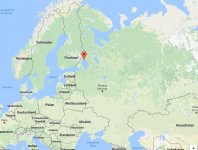Angela
Elite member
- Messages
- 21,823
- Reaction score
- 12,329
- Points
- 113
- Ethnic group
- Italian
The dude isn't perfect(eg, girl-snatching ANEs) but he's smart. He doesn't contradict academic findings.
Now whom should I believe? You or my lying eyes? The percentages from his calculator are very different from the ones in Haak et al. Or didn't you bother to compare them?
As for your post #14, who said the Baltics and Finland don't have Corded Ware ancestry? Stop creating straw man arguments.


